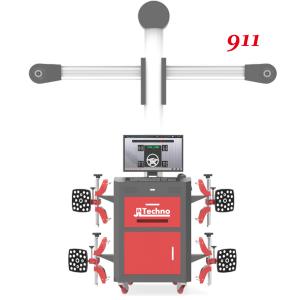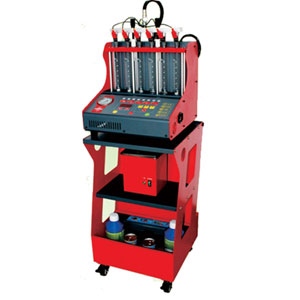If you have any knowledge about wheel alignment, you've probably heard the terms Camber, Caster and Toe-in, but there are few others that you might need to know about.
Camber
Caster
Toe-in
Kingpin (KPI) or Steering Axis Inclination (SAI)
Included Angle
Scrub Radius
Riding Height
Set Back
Centerline of the wheel
Vehicle’s centerline
Thrust Angle
Steering Center
Toe Out on Turns
 Camber
Camber
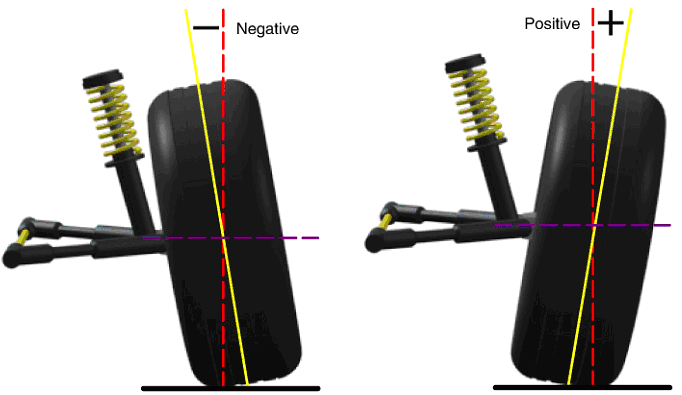
Camber is the angle of the wheel, measured in degrees, when viewed from the front of the vehicle. If the top of the wheel is leaning out from the center of the car, then the camber is positive ,if it's leaning in, then the camber is negative. If the camber is out of the proper range, it will cause tire wear on one side of the tire's tread. If the camber is too far negative, for instance, then the tire will wear on the inside of the tread. Correct Camber can equalize the loads applied on each part of the axle so that the life of the parts can be prolonged and reduce the tyre wear.
If the camber is different from one side to another side, it can cause a pulling problem. The vehicle will pull to the side with the more positive camber. On many front-wheel-drive vehicles, camber is not adjustable. If the camber is out on these cars, it indicates that something is worn or bent, possibly from an accident and must be repaired or replaced.
When camber specifications are determined during the design stage, a number of factors are taken into account. The engineers account for the fact that wheel alignment specifications used by alignment technicians are for a vehicle that is not moving. On many vehicles, camber changes with different road speeds. This is because aerodynamic forces cause a change in riding height from the height of a vehicle at rest. Because of this, riding height should be checked and problems corrected before setting camber. Camber specs are set so that when a vehicle is at highway speed, the camber is at the optimal setting for minimum tire wear.
For many years the trend has been to set the camber from zero to slightly positive to offset vehicle loading, however the current trend is to slightly negative settings to increase vehicle stability and improve handling.
 Caster
Caster
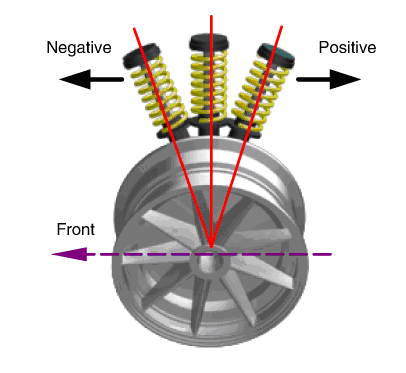
When you turn the steering wheel, the front wheels respond by turning on a pivot attached to the suspension system. Caster is the angle of this steering pivot, measured in degrees, when viewed from the side of the vehicle. If the top of the pivot is leaning toward the rear of the car, then the caster is positive, if it is leaning toward the front, it is negative. If the caster is out of adjustment, it can cause problems in straight line tracking. If the caster is different from side to side, the vehicle will pull to the side with the less positive caster. If the caster is equal but too negative, the steering will be light and the vehicle will wander and be difficult to keep in a straight line. If the caster is equal but too positive, the steering will be heavy and the steering wheel may kick when you hit a bump. Caster has little affect on tire wear.
The best way to visualize caster is to picture a shopping cart caster. The pivot of this type of caster, while not at an angle, intersects the ground ahead of the wheel contact patch. When the wheel is behind the pivot at the point where it contacts the ground, it is in positive caster. Picture yourself trying to push the cart and keep the wheel ahead of the pivot. The wheel will continually try to turn from straight ahead. That is what happens when a car has the caster set too far negative. Like camber, on many front-wheel-drive vehicles, caster is not adjustable. If the caster is out on these cars, it indicates that something is worn or bent, possibly from an accident, and must be repaired or replaced.
Positive caster improves straight line tracking because the caster line (the line drawn through the steering pivot when viewed from the side) intersects the ground ahead of the contact patch of the tire. Just like a shopping cart caster, the wheel is forced behind the pivot allowing the vehicle to track in a straight line.
If this is the case, then why did most cars have negative caster specs prior to 1975 ? There are a couple of reasons for this. In those days, people were looking for cars that steered as light as a feather, and cars back then were not equipped with radial tires. Non-radial tires had a tendency to distort at highway speed so that the contact patch moved back past the centerline of the tire (Picture a cartoon car speeding along, the tires are generally drawn as egg-shaped). The contact patch generally moves behind the caster line causing, in effect, a positive caster. This is why, when you put radial tires on this type of car, the car wanders from side to side and no longer tracks straight. To correct this condition, re-adjust the caster to positive and the car should steer like a new car.
 Toe-in
Toe-in
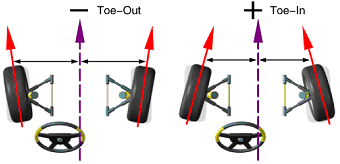
The toe measurement is the difference in the distance between the front of the tires and the back of the tires. It is measured in fractions of an inch in the US and is usually set close to zero which means that the wheels are parallel with each other. Toe-in means that the fronts of the tires are closer to each other than the rears. Toe-out is just the opposite. An incorrect toe-in will cause rapid tire wear to both tires equally. This type of tire wear is called a saw-tooth wear pattern as shown in this illustration.
If the sharp edges of the tread sections are pointing to the center of the car, then there is too much toe-in. If they are pointed to the outside of the car then there is too much toe-out. Toe is always adjustable on the front wheels and on some cars, is also adjustable for the rear wheels.
Like camber, toe will change depending on vehicle speed. As aerodynamic forces change the riding height, the toe setting may change due to the geometry of the steering linkage in relation to the geometry of the suspension. Because of this, specifications are determined for a vehicle that is not moving based on the toe being at zero when the vehicle is at highway speed. In the early days prior to radial tires, extra toe-in was added to compensate for tire drag at highway speed.
On some older alignment machines, toe-in was measured at each wheel by referencing the opposite wheel. This method caused problems with getting the steering wheel straight the first time and necessitated corrective adjustments before the wheel was straight. Newer machines reference the vehicle's centerline by putting instruments on all four wheels. For more information on this see Steering Center and Thrust angle.
 Kingpin (KPI) or Steering Axis Inclination (SAI)
Kingpin (KPI) or Steering Axis Inclination (SAI)
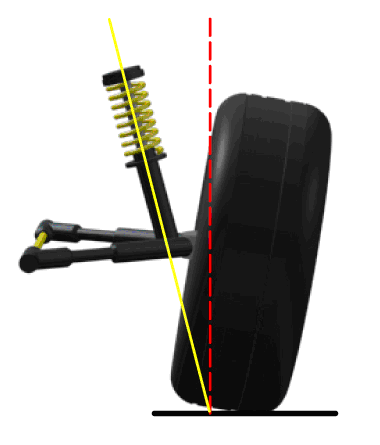
Kingpin or Steering Axle Inclination (KPI or SAI) is the angle of inclination of the king pin towards the centre-line of the vehicle from the vertical. SAI is also referred to as KPI (King Pin Inclination) on trucks and old cars with king pins instead of ball joints. This angle, when added to the camber to form the included angle (see below) causes the vehicle to lift slightly when you turn the wheel away from a straight ahead position. This action uses the weight of the vehicle to cause the steering wheel to return to the center when you let go of it after making a turn. Correct King Pin Inclination can equalize the loads applied on bearings so that the life of bearings can be prolonged and the controllability of steering is improved. Without the inclination, the controllability of the steering may be affected; further more, the vehicle weight and the ground counterforce may cause significant stress in the axle and finally damage the axle .Correct inclination of king pin is also helpful for the vehicle to restore its straight-ahead position after steering. King Pin Inclination is determined when the vehicle suspension is designed. It is not service adjustable. The most likely cause for SAI being out is bent parts which must be replaced to correct the condition. Most alignment machines have a way to measure SAI by calculation.
 Included Angle
Included Angle
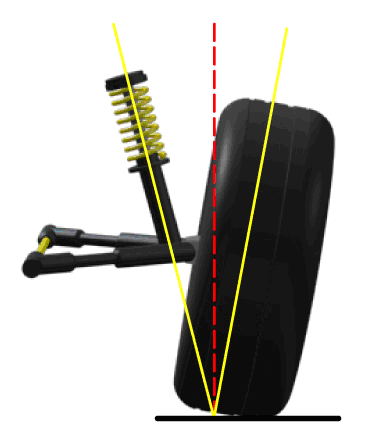
Included angle is the angle formed between the SAI and the camber. Included angle is not directly measurable. To determine the included angle, you add the SAI to the camber. If the camber is negative, then the included angle will be less than the SAI, if the camber is positive, it will be greater. The included angle must be the same from side to side even if the camber is different. If it is not the same, then something is bent, most likely the steering knuckle.
 Scrub Radius
Scrub Radius
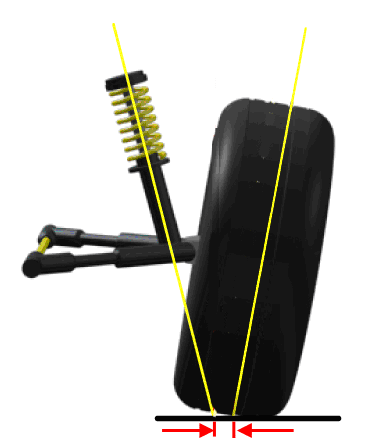
Scrub radius is the distance between where the SAI intersects the ground and the center of the tire. This distance must be exactly the same from side to side or the vehicle will pull strongly at all speeds. While included angle problems will affect the scrub radius, it is not the only thing that will affect it. Different wheels or tires from side to side will cause differences in scrub radius as well as a tire that is low on air. Positive scrub radius is when the tire contact patch is outside of the SAI pivot, while negative scrub radius is when the contact patch is inboard of the SAI pivot (front wheel drive vehicles usually have negative scrub radius).
If the brake on one front wheel is not working, with positive scrub radius, stepping on the brake will cause the steering wheel to try to rip out of your hand. Negative scrub radius will minimize that effect.
Scrub radius is designed at the factory and is not adjustable. If you have a vehicle that is pulling even though the alignment is correct, look for something that will affect scrub radius.
 Riding Height
Riding Height
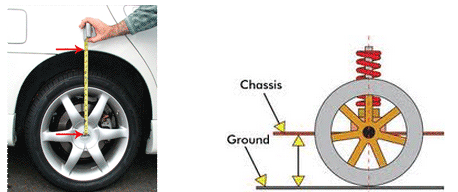
There are two ways of measure riding height. please follow the instruction of the wheel aligner you are using to measure riding height.
Riding height is measured, usually in inches, from the rocker panel to the ground. Good wheel alignment charts provide specs, but the main thing is that the measurements should be within one inch from side to side and front to rear. Riding height is not adjustable except on vehicles with torsion bar type springs. The best way to fix this problem is to replace the springs (Note: springs should only be replaced in matched pairs). Changes in riding height will affect camber and toe so if springs are replaced or torsion bars are adjusted, then the wheel alignment must be checked to avoid the possibility of tire wear. It is important to note that the only symptom of weak coil springs is a sag in the riding height. If the riding height is good, then the springs are good.
Make sure the car is on a level / flat surface and that the front wheels are pointed straight. (Yes it makes a difference!) Also note the amount of fuel, if you have a trailer hitch, Volvo Subwoofer or any other items in the trunk / cargo area that might effect the ride height.
 Set Back
Set Back
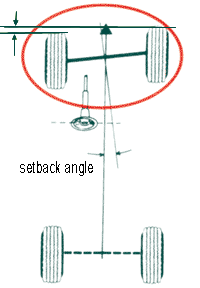
Set-back is the angle between the line which passes through the center points of two front wheels and two rear wheels and the perpendicular line of thrust line. If right wheel is in front of left wheel, the set-back is positive, if not, negative. If tread is known, set-back can be denoted with mm.
A set back of less than 1/4 inch is considered normal tolerance by some manufacturers. More than that and there is a good chance that something is bent.
 Centerline of the wheel
Centerline of the wheel
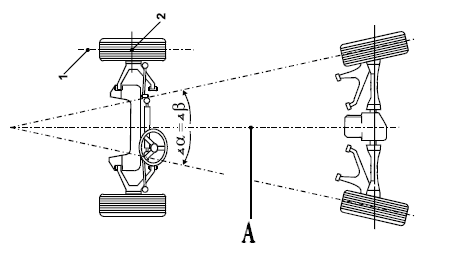
Contact between the tyre and the ground forms a line to which centerline of the wheel is vertical. A- Centerline of the wheel.
 Vehicle’s centerline
Vehicle’s centerline
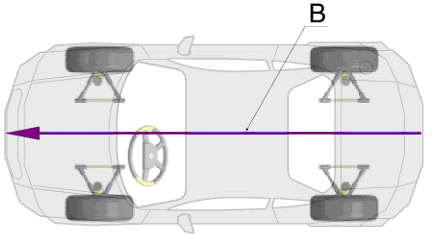
The line which passes through the center point of front axle and the center point of rear axle. B- Vehicle’s centerline (i.e. geometry centerline).
Return
 Thrust Angle
Thrust Angle
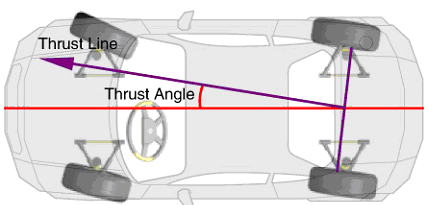
The angle between the vehicle’s centerline and the vehicle thrust line. When driving, the front wheels and the rear wheels should pull to the same side if the thrust angle is not zero. When thrust line is at the left side of the vehicle’s centerline, the thrust angle is positive, otherwise is negative.
The existence of the thrust angle causes the vehicle’s rear part pull to one side. In order to drive the vehicle straight-ahead, the front wheels have to turn to the direction of thrust line. If thrust angle compensation is not done for front toe, the steering wheel must be turned to one side when driving straight-ahead. If rear toe can be adjusted, the thrust angle should be adjusted close to zero.
The direction of thrust line is the actual driving direction of the vehicle, which is determined by rear toe. When the direction of thrust line doesn’t coincide with the geometric centerline of the vehicle, the steering wheel must be turned by some degrees to keep the vehicle driving straight-ahead, so that unbalance phenomenon of the steering wheel is caused. At the same time, the traveling pathes of rear wheels don’t coincide with that of front wheels. This kind of phenomenon is called Rear Wheel Lateral Move.
If ignore the thrust line, the veracity of alignment cannot be ensured. This is the main reason of the steering deflection.
Return
 Steering Center
Steering Center
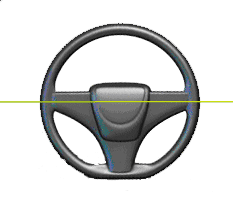
Steering center is simply the fact that the steering wheel is centered when the vehicle is traveling down a straight and level road. A crooked steering wheel is usually the most common complaint that a customer has after a wheel alignment is performed. Assuming that the steering wheel stays in the same position when you let go of the wheel (in other words, the car is not pulling), then steering center is controlled by the front and rear toe settings. When setting steering center, the rear toe should be set first bringing the Thrust Angle as close to the vehicle centerline as possible. Then the steering wheel is locked in a straight ahead position while the front toe is set. Before locking the steering wheel, the engine should be started and the wheel should be turned right and left a couple of times to take any stress off the power steering valve. After setting the toe, the engine should be started again to be sure that the steering valve wasn't loaded again due to the tie rod adjustments. Of course, you should always road test the vehicle after every alignment as a quality control check.
Another problem with steering center has to do with the type of roads that are driven on. Most roads are crowned to allow for water drainage, and unless you drive in England, Japan or another country where they drive on the left side of the road, you usually drive on the right side of the crown. This may cause the vehicle to drift to the right so that the steering wheel will appear to be off-center to the left on a straight road. The best way to compensate for this is as follows:
If there is a difference in caster, it should be that the left wheel is more negative than the right wheel, but not more than 1/2 degree. Check the specs for any specific recommendations on side-to-side differences.
If there is a difference in camber, then the left wheel should be more positive than the right wheel. Check the specs to see what the allowable difference is.
Return
 Toe Out on Turns
Toe Out on Turns
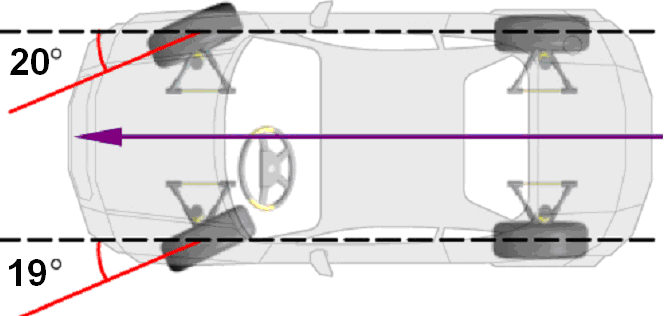
When you steer a car through a turn, the outside front wheel has to navigate a wider arc then the inside wheel. For this reason, the inside front wheel must steer at a sharper angle than the outside wheel.
Toe-out on turns is measured by the turning angle gauges (turn plates) that are a part of every wheel alignment machine. The readings are either directly on the turn plate or they are measured electronically and displayed on the screen. Wheel alignment specifications will usually provide the measurements for toe-out on turns. They will give an angle for the inside wheel and the outside wheel such as 20º for the inside wheel and 18º for the outside wheel. Make sure that the readings are at zero on each side when the wheels are straight ahead, then turn the steering wheel so that the inside wheel is at the inside spec. then check the outside wheel.
The toe-out angles are accomplished by the angle of the steering arm. This arm allows the inside wheel to turn sharper than the outside wheel. The steering arm is either part of the steering knuckle or part of the ball joint and is not adjustable. If there is a problem with the toe-out, it is due to a bent steering arm that must be replaced.
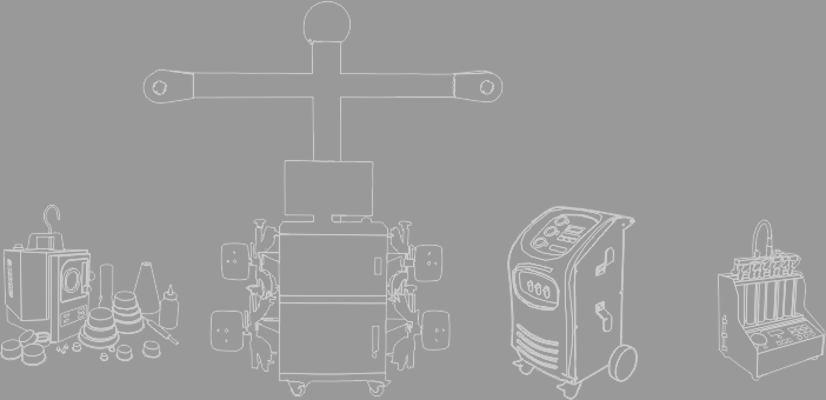
 Camber
Camber
 Caster
Caster
 Toe-in
Toe-in 
 Kingpin (KPI) or Steering Axis Inclination (SAI)
Kingpin (KPI) or Steering Axis Inclination (SAI)
 Included Angle
Included Angle
 Scrub Radius
Scrub Radius 
 Riding Height
Riding Height
 Set Back
Set Back
 Centerline of the wheel
Centerline of the wheel
 Vehicle’s centerline
Vehicle’s centerline
 Thrust Angle
Thrust Angle
 Steering Center
Steering Center
 Toe Out on Turns
Toe Out on Turns
